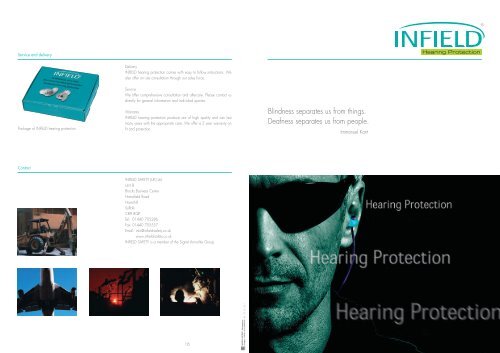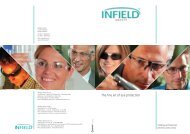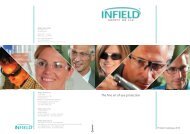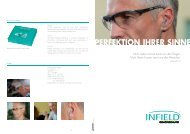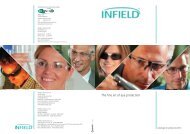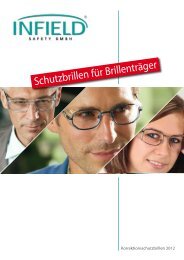Infield Gehoer 16-S GB - infield-safety
Infield Gehoer 16-S GB - infield-safety
Infield Gehoer 16-S GB - infield-safety
You also want an ePaper? Increase the reach of your titles
YUMPU automatically turns print PDFs into web optimized ePapers that Google loves.
Service and delivery<br />
Package of INFIELD hearing protection<br />
Contact<br />
Delivery<br />
INFIELD hearing protection comes with easy to follow instructions. We<br />
also offer on-site consultation through our sales force.<br />
Service<br />
We offer comprehensive consultation and aftercare. Please contact us<br />
directly for general information and individual queries.<br />
Warranty<br />
INFIELD hearing protection products are of high quality and can last<br />
many years with the appropriate care. We offer a 2 year warranty on<br />
fit and protection.<br />
INFIELD SAFETY (UK) Ltd.<br />
Unit B<br />
Brocks Business Centre<br />
Homefield Road<br />
Haverhill<br />
Suffolk<br />
CB9 8QP<br />
Tel: 01440 705286<br />
Fax: 01440 705557<br />
Email: info@<strong>infield</strong>-<strong>safety</strong>.co.uk<br />
www.<strong>infield</strong>-<strong>safety</strong>.co.uk<br />
INFIELD SAFETY is a member of the Signet Armorlite Group.<br />
<strong>16</strong><br />
© 07.12.110.1<br />
Blindness separates us from things.<br />
Deafness separates us from people.<br />
Immanuel Kant
Table of contents<br />
Subject Page<br />
Introduction 3<br />
The human ear 4<br />
Hearing – how does it work? 5<br />
What is loud? 5-6<br />
Protective capacity 6<br />
Hearing loss caused by noise 7<br />
Legislation and directives 8<br />
Frequency analysis 8<br />
Frequency analysis jargon 9<br />
Customised hearing protection made by INFIELD 10<br />
Advantages of INFIELD’s ear plugs 10<br />
Material 10<br />
Moulding and manufacture 11<br />
Compact Filter 12<br />
Clear Sound Filter 13<br />
Phonor Pro Filter 14<br />
Seal Integrity Test 15<br />
(Air-) Leakage Test 15<br />
Acoustic Test 15<br />
Service and delivery <strong>16</strong><br />
Contact <strong>16</strong><br />
2<br />
Hearing damage caused by noise is irreversible<br />
We’re asleep. Our entire body is at rest. The muscles, the eyes, the ears –<br />
or so you think! Our ears never sleep! Or how could you explain that we<br />
are awoken by sounds? Be it an intruder alarm, a smoke detector, a crying<br />
baby, a coughing partner or the alarm clock: It wakes us up. This proves that<br />
our ears are wide awake while we’re asleep – all the time.<br />
Most people are unaware of the health problems that noise can cause.<br />
Especially young people expose their ears to high levels of noise by going<br />
to rock concerts and night clubs or using MP-3 players with earphones. In<br />
the medical profession recognises 85dB (Decibel) as the threshold for<br />
hearing damage, 120 -130dB as the pain barrier – this equates to a jet<br />
plane at take-off at 100m distance. The background noise in houses is<br />
typically 40-50dB, in offices 65dB. Traffic noise can easily amount to<br />
85dB, rock concerts and night clubs at 110dB are often louder than<br />
jackhammers giving off 100dB. An increase of 3dB doubles the charge on<br />
the ears.<br />
In the workplace the noise level at which hearing protection must be worn<br />
is legislated. But often the provided equipment isn’t worn by workers - but<br />
why? One reason is that some hearing protection lacks comfort and<br />
practicality, because it makes communication almost impossible. As a<br />
consequence the user feels isolated. Some users also complain about<br />
headaches, contact allergies or sweating under the equipment.<br />
Customised hearing protection by INFIELD Safety is comfortable and reduces<br />
the noise level without acoustic isolation of the user.<br />
In this brochure you will discover how the <strong>safety</strong> experts at INFIELD have<br />
achieved the production of quality hearing protection that provides high user<br />
comfort also.<br />
3<br />
Introduction<br />
Reasons for rejection of hearing protection<br />
INFIELD earplugs
Anatomy of the human ear<br />
Diagram of the ear<br />
1. Outer ear<br />
2. Ear canal<br />
3. Eardrum<br />
4. Hammer<br />
5. Anvil<br />
6. Stirrup<br />
7. Oval window<br />
8. Semicircular canals<br />
9. Auditory nerve<br />
10. Cochlea<br />
11. Eustachian tube<br />
12. Round window<br />
13. Tympanic cavity<br />
Outer ear<br />
The outer ear is made up of the visible portion called the pinna and the ear<br />
canal. The human pinna’s functions are of no great importance, whilst<br />
animals can move and turn their ears to locate sounds.<br />
Middle ear<br />
The middle ear consists of eardrum, tympanic cavity and Eustachian tube.<br />
Inner ear<br />
The inner ear is made up of the organ of Corti and the cochlea.<br />
Ear canal<br />
The ear canal links the outer ear and the eardrum. It is approximately 3-4cm<br />
in depth and 0.5-1cm in diameter. It is completely covered with skin. The<br />
outermost part of the ear canal near the pinna is supported by cartilage, the<br />
inner part by bone. In the section made up of cartilage sebaceous glands<br />
secrete the yellow cerumen which is expelled by tiny hairs.<br />
Eardrum<br />
Between the ear canal and the tympanic cavity lies the eardrum. This membrane<br />
is approximately 1cm in diameter and 0.1mm thick. On the inside of<br />
the eardrum is a mucous membrane; from the outside it looks grey and shiny.<br />
Tympanic cavity<br />
In the tympanic cavity there are the three ear bones or ossicles: hammer,<br />
anvil and stirrup as well as the semicircular canals of the vestibular<br />
apparatus.<br />
Hammer, anvil and stirrup<br />
The hammer, anvil and stirrup are three tiny bones that are connected to<br />
each other. They directly couple and amplify sound energy from the eardrum<br />
to the inner ear.<br />
Oval window<br />
Sound waves travel via this membrane from the ossicles to the inner ear. The<br />
inner ear is located in the cochlea, well protected by the petrous portion of<br />
the temporal bone (‘pyramid’).<br />
Round Window<br />
The round window is positioned adjacent to the oval window and is the end<br />
point of the scala tympani.<br />
Eustachian tube<br />
The Eustachian tube links the tympanic cavity with the pharynx. Its main<br />
function is pressure equalisation in the ear.<br />
Cochlea<br />
The cochlea has three ducts called scalae: the scala vestibuli and the scala<br />
tympani, which both contain perilymph. Between these two is the scala<br />
media filled with endolymph which contains the organ of Corti. The word<br />
cochlea is the latin word for snail and comes from the shape of the organ.<br />
Organ of Corti<br />
The organ of Corti is the essential part of our hearing. It is located in the<br />
cochlea and contains 25,000 hair cells, each equipped with 100 hairs<br />
called stereocilia. These hairs are the sensory receptors of the auditory<br />
system and pass on information from sound waves via the auditory nerve to<br />
the brain.<br />
4 5<br />
To be precise, the human ear doesn’t process sounds, but sound waves that<br />
resonate with the eardrum. The resonance is amplified by the ossicles in the<br />
tympanic cavity and reaches the inner ear through the oval window, where<br />
the actual hearing process begins.<br />
A very important factor in the hearing process is the frequency of sound. The<br />
unit of frequency is Hertz (Hz) and is a measure of the number of sound<br />
waves per second.<br />
The amplification of sounds by the ossicles depends on frequency. The best<br />
amplification of sounds is achieved in the range of the human voice, i.e. between<br />
1000 and 2000 Hz.<br />
When a sound wave reaches the oval window via the previously mentioned<br />
pathway, it is passed on via the perilymph inside the scala vestibuli to<br />
trigger the basilar membrane. Depending on the frequency, sensory hairs in<br />
different locations on the organ of Corti are triggered. An analogy would be<br />
waves breaking at specific points on the beach, depending on their size.<br />
This way we can distinguish between high and low pitches. From the<br />
stereocilia the sound wave travels on towards and resonates with Reissner’s<br />
membrane. This resonance then triggers receptor cells that send an electric<br />
impulse along the auditory nerve to the brain. Here the sound is recognised<br />
and defined e.g. as a note or a word. The ear responds 7 times faster than<br />
the eye. If we could see as fast as we can hear, we would see every single<br />
frame in TV broadcasts instead of fluid movements.<br />
A sound is not only defined by its frequency but also by its volume. This is<br />
measured in decibel (dB). The table below lists typical everyday sounds and<br />
the noise level they cause.<br />
The human pain barrier for sounds is about 120dB, i.e. at volumes above<br />
120dB we perceive the sound as a physical pain in our ears.<br />
If we have to raise our voice in a conversation at a distance of 1m, the<br />
background noise level is about 80dB or more. It is not advisable to expose<br />
the ears to such noise levels for prolonged periods without hearing<br />
protection.<br />
Hearing – how does it work?<br />
Cochlea<br />
1. Stirrup<br />
2. Oval window<br />
3. Helicotrema<br />
4. Scala vestibule<br />
5. Organ of Corti<br />
6. Scala tympani<br />
7. Round window<br />
Diagram of the cochlea<br />
1. Scala vestibule<br />
2. Organ of Corti<br />
3. Scala tympani<br />
4. Auditory nerve<br />
What is loud?<br />
Examples of noise levels in Decibel
What is loud?<br />
Logarithmic increase of volume (dB) in comparison to<br />
weight (kg)<br />
Protective capacity<br />
Decrease of protective capacity<br />
Volume is often underestimated because the decibel scale is not linear but<br />
logarithmic. This means that for every 10dB the intensity rises by 10-fold. To<br />
illustrate the difference, weights can be used as an example.<br />
Going from 60dB to 70dB is particularly dramatic: 10dB is the same<br />
proportional difference as there is between the weight of an average adult<br />
and a family car.<br />
When going 10dB higher the analogy in weight is a heavy goods vehicle.<br />
The duration of exposure is an important factor in hearing loss. The human<br />
ear has its own protective capacity, similar to the role of melanin in the skin<br />
to protect it from UV radiation. Hence we can expose our ears to 80dB for<br />
8 hours without any lasting damage. An increase of 3dB to 83dB halves<br />
this exposure time, i.e. 4 hours are safe. Please refer to the diagram for<br />
further protective capacity times.<br />
If you are exposed to noise levels of 80dB or above, hearing protection<br />
becomes a necessity to prevent lasting damage to your ears.<br />
6 7<br />
Continuous exposure to noise causes hearing loss that is irreversible in 95%<br />
of all cases.<br />
Very often our bodies show symptoms that are not obviously linked with<br />
noise, like insomnia, poor concentration and cardiovascular disease. If you<br />
suffer from any of these complaints, it is advisable that your surroundings are<br />
analysed for noise. In case that sources of dangerous noise levels have been<br />
identified and cannot be eliminated, hearing protection must be worn. Find<br />
more conditions associated with noise damage in the following paragraphs.<br />
Conductive hearing loss<br />
Damage to the ossicles (hammer, anvil and stirrup) renders them unable to<br />
amplify sounds adequately. This results in a hearing loss of approximately<br />
20dB.<br />
Sensorineural hearing loss<br />
Loud noises destroy the hair cells in the organ of Corti and can cause partial<br />
or complete loss of hearing.<br />
Tinnitus<br />
Around 3 Million people suffer from tinnitus (Latin for ‚ringing’). This constant<br />
noise in the ears is mostly described as a whistling sound, but can also take<br />
the form of a buzzing, whooshing or rattling. It can not be measured but is<br />
proven to lead to psychological problems and even suicide. There are many<br />
attempts for therapy but no guarantees for a successful cure. Tinnitus is not<br />
only caused by noise but also by stress, middle ear infection, decreased<br />
blood flow to the inner ear or some medications.<br />
Vertigo<br />
Because the vestibular system located in the inner ear is also responsible for<br />
the sense of balance, damage to the ear can also cause vertigo and<br />
dizziness.<br />
Often these symptoms are ignored, because they aren’t very obvious at first<br />
and they have a very slow progression. Protect yourself, your employees and<br />
your relatives with individually fitted hearing protection.<br />
Hearing loss caused by noise
Legislation and directives<br />
Frequency analysis<br />
First of all, the term ’noise’ needs to be defined. Legislation describes it as<br />
‘any type of sound that disturbs, bothers or damages the health of people,<br />
i.e. all sounds that compromise physical, mental and social well-being’.<br />
According to a new EU guideline (2006) the following applies:<br />
- at 80dB or above, hearing protection must be provided<br />
- at 85dB or above, hearing protection must be worn<br />
Hearing protection on sale in Europe needs a CE-mark, i.e. comply with the<br />
standards of the European Committee of Standardisation (CEN). Within<br />
these EU-standards, hearing protection falls into the category of ‘personal<br />
protective wear’ and is divided into three sub-categories:<br />
• EN 352-1: ear-muffs<br />
•EN 352-2: ear-plugs<br />
• EN 352-3: ear-muffs attached to <strong>safety</strong> helmets<br />
This has been replaced in 2003 by a new series of EU-directives:<br />
•EN 13819-1: physical test methods for hearing protection<br />
•EN 13819-2: acoustic test methods for hearing protection<br />
• The old 352-series is limited to the specific demands that are set by<br />
delivery conditions and guidelines<br />
For optimum protection detailed knowledge of the work environment of the<br />
end user is needed. The noise level in manufacture is not only made up of<br />
the machine in use but also many other background noises with different<br />
frequencies. Specialists have fixed 1000Hz as the standard frequency; this<br />
is the lower range of the human voice. A professional frequency analysis as<br />
it is carried out by INFIELD always refers to 1000Hz as well as six other<br />
frequencies. Three of these frequencies are higher in octave steps; three are<br />
lower in octave steps. The fixed frequencies are 125, 250, 500, 1000,<br />
2000, 4000 and 8000Hz. Please note that a comprehensive frequency<br />
analysis is a sign of professionalism and quality of service.<br />
In the frequency based tables for noise reduction you find a lot of numbers<br />
we would like to explain to you. Now that you are familiar with how these<br />
frequencies have been chosen, we’ll explain more about the individual<br />
numbers.<br />
8 9<br />
The M f - value, measured in dB, determines the mean attenuation of a<br />
frequency. For example 25dB at 500Hz means a noise reduction of 25dB<br />
at the frequency of 500Hz.<br />
The APV (Assumed Protection Value) is measured in dB. The CE-mark is only<br />
issued for hearing protection if this value is above legislated level. The APV<br />
should not be less than declared for 84% of end users.<br />
The S f - value (in dB) is an assumed standard deviation that contributes<br />
towards the determination of the APV.<br />
The SNR - value is the mean attenuation for the complete analysed spectrum<br />
of frequencies, i.e. from 125-8000Hz.<br />
The H/M/L - values are the mean attenuation in the respective areas of<br />
frequencies.<br />
H = High frequency (2000-8000Hz)<br />
M=Medium frequency (500-2000Hz)<br />
L = Low frequency (125-500Hz)<br />
The graphs illustrate the attenuation that is achieved by the individual<br />
acoustic filters. Customised hearing protection provides attenuation that is<br />
evenly balanced across the relevant spectrum of frequencies in contrast to<br />
standard hearing protection.<br />
Frequency analysis jargon<br />
Legislated APVs for the CE-mark<br />
Attenuation table in original size: pages 12-14
Customised hearing protection made by INFIELD<br />
Advantages of INFIELD’s ear plugs<br />
Material<br />
We offer three types of ear plugs to furnish a range of requirements:<br />
• Compact<br />
•ClearSound<br />
• Phonor® Pro<br />
The Compact FlexComfort and ClearSound both come with a complimentary<br />
set of accessories:<br />
•Cord with clip<br />
•Cleaning stick and Otoferm cream<br />
• Case<br />
The Phonor® Pro comes with complimentary:<br />
•Case and cleaning stick<br />
Cleaning spray and tissues can be ordered as accessories.<br />
Special models<br />
All models can be fitted with a tiny metal ball (detection ball). These<br />
specialised models are mainly of interest to the food and chemical industries.<br />
•Customised for perfect fit<br />
• Optimum protection<br />
•Communication is retained<br />
• Filters are individually adjusted to the environment<br />
•Important sounds and signals can still be heard<br />
•Ideal comfort, hardly noticeable<br />
•High user acceptance<br />
• Easy to wear with <strong>safety</strong> helmets<br />
• Almost invisible<br />
• Easy to use<br />
• Easy to clean<br />
The standard material for all our models is silicone, which provides good<br />
mechanical and chemical resistance combined with a long life span. The<br />
soft, flexible material causes no pressure points in the ear canal, even with<br />
prolonged wearing. The basic standard issue of the ear plugs is transparent<br />
silicone, but they can also be produced from a harder acrylate plastic and<br />
in a range of signal colours like red, blue or yellow.<br />
10 11<br />
The ear plug is custom moulded to each user and consists of the silicone plug<br />
and the acoustic filter itself.<br />
Before fitting the ear plug, a medical examination has to be carried out to<br />
assess that it is safe to inject the moulding putty into the ear canal. During<br />
this examination, excess cerumen (earwax) or cerumen plugs should be syringed<br />
from the ear canal.<br />
The moulding is performed according to current best practice for the fitting<br />
of hearing aids. The moulding material is a pliable two-component putty<br />
based on silicone. This is injected into the ear canal without any noticeable<br />
pressure. The moulding process is normally not uncomfortable. The result is<br />
a perfect copy of the ear canal and part of the pinna.<br />
In the next production step, this mould is then used to form the final earpiece.<br />
It fits perfectly into the ear canal and provides a tight fit. Then a hole is<br />
drilled into the part that inserts into the ear canal. Now the appropriate<br />
acoustic filter is fitted, specifically tuned to your requirements for noise reduction.<br />
Compared to other systems, custom made hearing protection has many<br />
advantages. It is anatomically fitted to each user’s ear canal, therefore can<br />
neither slip nor cause pressure points and the protection is consistent throughout<br />
usage. It doesn’t close up the ear canal completely, but is ventilated<br />
through the acoustic filter, which also allows pressure equalisation. In this<br />
way user comfort is maximised.<br />
The large range of acoustic filters allows for a multitude of noise environments,<br />
eliminating under- or over-protection.<br />
Moulding and manufacture<br />
Moulding process with the injector gun<br />
Moulding the gypsum cast<br />
Refining the first mould<br />
Drilling the hole for the acoustic filter
Compact Filter<br />
Earplug with Compact Filter<br />
Broad band filter<br />
The 4 filters of choice MM 12, MM 22, MM 02 and ML 01 find their<br />
use in different situations to filter specific frequencies. They are unique in<br />
their broad band characteristics. The filters MM02 und ML01 are used<br />
at low frequencies (e.g. turbine manufacture, sheet metal production).<br />
12 13<br />
RC 19/18/17/15/13* - Range with reduced attenuation complying<br />
with the new EU noise directive. These broad spectrum filters have very<br />
linear attenuation properties and show no peaks in the spectrum of the<br />
human voice. These properties assure that the user doesn’t feel isolated<br />
and that voices, alarms and signals relevant to health and <strong>safety</strong> can still<br />
be heard. Main fields of use are in railway and monitoring of machine<br />
noises.<br />
* RC13: at 125Hz and 250Hz, the APV84 is with 0.9 and 1.3<br />
respectively lower than the minimum required attenuation with regards to<br />
EN 352-2, i.e. the standard CE does not apply.<br />
Clear Sound Filter<br />
Ear plug with Clear Sound filter<br />
Clear Sound filter
Phonor® Pro Filter<br />
Phonor® Pro Filter<br />
Tubular filter<br />
•Customised hearing protection, 100% made in Germany<br />
•2 acoustic filters with different characteristics<br />
• Choice of 2 materials: acrylate and FlexComfort<br />
•Available with or without cord<br />
•Detector ball available for easy tracking when lost<br />
• Filter is protected from dirt<br />
• Field of use in industry<br />
Pro M and Pro H – Both these filters are simple tubular filters that provide<br />
good protection at medium and high frequencies. They are not suited for<br />
use at low frequencies.<br />
The Pro filters meet the simpler requirements in industrial uses.<br />
There are two main methods to test the tight fit of customised hearing<br />
protection: the (air) leakage test and the acoustic test. Please note that the<br />
total attenuation is mainly a measure of the fit of the ear plug rather than the<br />
actual function of the acoustic filter. The main difference is that seal integrity<br />
tests are carried out for each ear (monaural) whilst the total attenuation is<br />
measured for both ears at the same time (binaural).<br />
If you require tests on your ear plug to confirm the high standard of our<br />
products, INFIELD can carry these out for you at your request.<br />
Procedure:<br />
A small pump that has been developed specifically for this task increases the<br />
pressure between the ear plug and the eardrum. The ear plug has a tight fit,<br />
if the pressure doesn’t decrease.<br />
Advantages:<br />
• Quick and simple method<br />
•No special facilities necessary<br />
• Objective - does not rely on the test persons’ perception<br />
Disadvantages:<br />
• The cable connector can temporarily alter the fit of the ear plug and have<br />
a negative influence on the test results<br />
• The test environment should not be too loud as this can alter the test results<br />
• Can not be applied to all ear plugs<br />
The test is carried out with a micro processor, which is fitted with two microphones.<br />
One of the microphones is connected to the ear plug and measures<br />
the noise level behind the hearing protection (in front of the eardrum). The<br />
other one measures the noise level in front of the hearing protection. After<br />
applying the ear plug to the ear, a low frequency test sound is generated.<br />
The difference in noise levels is the total attenuation.<br />
Advantages:<br />
• Precise measure of attenuation in dB<br />
• Quick and simple method<br />
• Objective - does not rely on the test persons’ perception<br />
•No special facilities necessary<br />
14 15<br />
Disadvantages:<br />
• The test environment should not be too loud as this can alter the test results<br />
Seal integrity test<br />
(Air-) Leakage test<br />
(Air-) Leakage test<br />
Acoustic test<br />
Acoustic test


